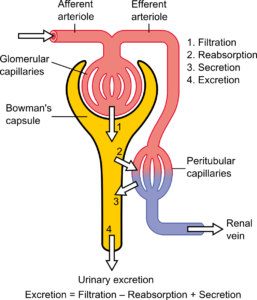Osmoregulation is defined as the maintenance of constant osmotic pressure in an organism’s body fluids by controlling salt and water concentrations.
Osmotic pressure is the measure of how water tends to move from one solution to another by osmosis. The greater the osmotic pressure of a given solution, the higher the tendency of water to move into it.
Organisms that live in aquatic and terrestrial environments must maintain the correct concentration of water and solutes in their body fluids. This is achieved through excretion of metabolic nitrogenous waste materials and other substances like hormones which would be toxic to the body in higher concentrations through body organs such as kidneys and skin.
Urine formation.
Urine is formed through the following stages:
- Filtration
- Reabsorption
- Secretion.
Filtration of urine.
The glomerulus filters water and other substances from the human bloodstream. Over one million nephrons in the kidney, each has a glomerulus which acts as the point of blood filtration.
The glomerulus is a network of capillaries surrounded by the Bowman’s capsule. During the flow of blood through the glomerulus, blood pressure forces solutes and water into the capsule from capillaries through a filtration membrane, thus the start of urine formation.
This filtration membrane keeps large proteins and blood cells in the bloodstream while allowing water and small solutes to go through. The filtrate then into the nephron from the glomerular capsule.
Reabsorption of urine.
Reabsorption is used to move back nutrients and water into the bloodstream. The filtrate membrane is used to filter water and small substances out of the bloodstream. Waste and other substances needed by the body, such as amino acids, glucose, smaller proteins, and essential ions are present in the filtrate. The filtrate flows into the renal tube after it exits the glomerulus, and as it moves, the reabsorption of water and needed substances occurs through the tube walls into the nearby capillaries. This is the second step in the creation of urine.
Secretion of waste ions and hydrogen ions.
The filtrate from the glomerulus flows into the renal tubule, where reabsorption of water and nutrients take place into the adjacent capillaries. Simultaneously, hydrogen ions and waste ions pass from the capillaries into the renal tubule, a process known as secretion.

The remnant filtrate combines with secreted ions to form urine, which flows from the nephron tubule into the collecting duct. It is passed through the renal pelvis, into the ureter, and finally down into the bladder for storage.